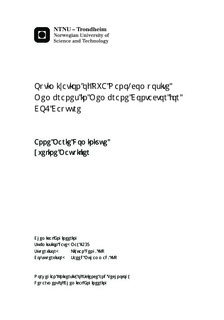| dc.contributor.advisor | Deng, Liyuan | nb_NO |
| dc.contributor.advisor | Muhammad, Saeed | nb_NO |
| dc.contributor.author | Maupilier, Anne Marie Dominique Yveline | nb_NO |
| dc.date.accessioned | 2014-12-19T13:23:58Z | |
| dc.date.available | 2014-12-19T13:23:58Z | |
| dc.date.created | 2013-09-16 | nb_NO |
| dc.date.issued | 2013 | nb_NO |
| dc.identifier | 648704 | nb_NO |
| dc.identifier | ntnudaim:9880 | nb_NO |
| dc.identifier.uri | http://hdl.handle.net/11250/248430 | |
| dc.description.abstract | The aim of this report is to evaluate and optimize poly vinyl alcohol (PVA) composite membrane containing nanoparticles such as carbon nanotubes (CNTs), titanium dioxide or biofibers cross-linked with glutaraldehyde for application in membrane contactor to capture CO2 at post combustion conditions.Defect free PVA composite membranes were developed in lab by casting a 3 weight percent aqueous PVA solution and 1 weight percent or 2 weight percent nanoparticles on micro porous PSf support. These membranes were then subjected to chemical cross-linking by adding 3 weight percent or 5 weight percent glutaraldehyde and heat treatment for physical cross-linking at a temperature of 110°C and exposure time of 1, 5 hours.Since PVA is a hydrophilic polymer and in a membrane contactor usually aqueous solutions are used to absorb CO2, the developed membranes were tested twice for permeance and selectivity at 100% humid conditions. For experimentation pre mixed gas containing 10% CO2 in nitrogen was feed to the membrane at three different pressures (1.2, 2 and 3bars). Helium was used as sweep gas. Swelling tests were performed to determine degree of swelling of each membrane, their theoretical equilibrium swelling degree and the swelling rate constant.From the experimentation it was observed that a same operating pressure membranes containing 2 weight percent CNTs have higher permeance whereas the opposite phenomenon is observed with membranes containing TiO2 and biofibers. However those results concerning TiO2 membranes can be explained by probable presence of agglomerates which decrease the mean pore size and an increase of viscosity leading to suppression of macrovoids which hence decreases permeance (Yu L-Y et al., 2009). Furthermore an increase of glutaraldehyde leads to a reduction of free volume and consequently a decrease of permeance. It has been observed that membranes containing biofibers have the highest permeance values, and membranes with 1wt% of TiO2 and 3% GA is then the best candidate. On the other hand membrane with 1wt% TiO2 and 5wt% GA has similar results to membrane containing 2wt% CNTs and 5wt% GA.Concerning swelling tests it was found that swelling degree increases rapidly before reaching a maximum and then remains stable which is similar to a typical swelling curve plot by Wu Q. and Feng Y. (2004) of a cross-linked polymer in solvent. Moreover it was observed that membranes containing 1wt% TiO2 have a higher swelling degree. Due to its hydrophilic nature TiO2 nanoparticles enhance swelling capacity of PVA by absorbing more water which results in a high free volume. Furthermore TiO2 membranes have also the smallest rate constant which means that they reach their maximum swelling degree faster than other membranes. Thus facilitate transport due to reaction between CO2 and water enhances rapidly transport through the membrane. To conclude membranes containing 1wt% of TiO2 particles seem to be the best option concerning swelling tests. | nb_NO |
| dc.language | eng | nb_NO |
| dc.publisher | Institutt for kjemisk prosessteknologi | nb_NO |
| dc.title | Optimization of PVA Nano-composite Membranes in Membrane Contactor for CO2 Capture | nb_NO |
| dc.type | Master thesis | nb_NO |
| dc.source.pagenumber | 77 | nb_NO |
| dc.contributor.department | Norges teknisk-naturvitenskapelige universitet, Fakultet for naturvitenskap og teknologi, Institutt for kjemisk prosessteknologi | nb_NO |

